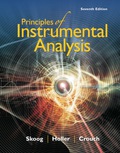
Concept explainers
(a)
Interpretation:
Comparison of ratio of atoms or ions in 3p states and in ground state of Na atom and Mg+ is to be done when there is a natural gas air flame of temperature 1800 K.
Concept introduction:
Boltzmann equation is used for the calculation of the ratio. This equation tells that how much an atom or ion is populated as a function of temperature. This equation is given as-
And the calculation of energy of atom and ion is done by the following formula-
Where,
h= Planck’s constant
c = light velocity
λ= wavelength
Ej= energy difference of excited state and ground state
(b)
Interpretation:
Comparison of ratio of atoms or ions in 3p states and in ground state of Na atom and Mg+ is to be done when there is a hydrogen - oxygen flame of 2950K.
Concept introduction:
Boltzmann equation is used for the calculation of the ratio. This equation tells that how much an atom or ion is populated as a function of temperature. This equation is given as-
And the calculation of energy of atom and ion is done by the following formula-
Where,
h= Planck’s constant
c = light velocity
λ= wavelength
Ej= energy difference of excited state and ground state.
(c)
Interpretation:
Comparison of ratio of atoms or ions in 3p states and in ground state of Na atom and Mg+ is to be done when there is an inductively −coupled plasma source of 7250 K.
Concept introduction:
Boltzmann equation is used for the calculation of the ratio. This equation tells that how much an atom or ion is populated as a function of temperature. This equation is given as-
And the calculation of energy of atom and ion is done by the following formula-
Where,
h= Planck’s constant
c = light velocity
λ= wavelength
Ej= energy difference of excited state and ground state.
Trending nowThis is a popular solution!

Chapter 8 Solutions
Principles of Instrumental Analysis
- Calculate the pH and the pOH of each of the following solutions at 25 °C for which the substances ionize completely: (a) 0.000259 M HClO4arrow_forwardWhat is the pH of a 1.0 L buffer made with 0.300 mol of HF (Ka = 6.8 × 10⁻⁴) and 0.200 mol of NaF to which 0.160 mol of NaOH were added?arrow_forwardDetermine if the following salt is neutral, acidic or basic. If acidic or basic, write the appropriate equilibrium equation for the acid or base that exists when the salt is dissolved in aqueous solution. If neutral, simply write only NR. Be sure to include the proper phases for all species within the reaction. NaN₃arrow_forward
- A. Draw the structure of each of the following alcohols. Then draw and name the product you would expect to produce by the oxidation of each. a. 4-Methyl-2-heptanol b. 3,4-Dimethyl-1-pentanol c. 4-Ethyl-2-heptanol d. 5,7-Dichloro-3-heptanolarrow_forwardWhat is the pH of a 1.0 L buffer made with 0.300 mol of HF (Ka = 6.8 × 10⁻⁴) and 0.200 mol of NaF to which 0.160 mol of NaOH were added?arrow_forwardCan I please get help with this.arrow_forward
- Determine if the following salt is neutral, acidic or basic. If acidic or basic, write the appropriate equilibrium equation for the acid or base that exists when the salt is dissolved in aqueous solution. If neutral, simply write only NR. Be sure to include the proper phases for all species within the reaction. N₂H₅ClO₄arrow_forwardPlease help me with identifying these.arrow_forwardCan I please get help with this?arrow_forward
 Principles of Modern ChemistryChemistryISBN:9781305079113Author:David W. Oxtoby, H. Pat Gillis, Laurie J. ButlerPublisher:Cengage Learning
Principles of Modern ChemistryChemistryISBN:9781305079113Author:David W. Oxtoby, H. Pat Gillis, Laurie J. ButlerPublisher:Cengage Learning

